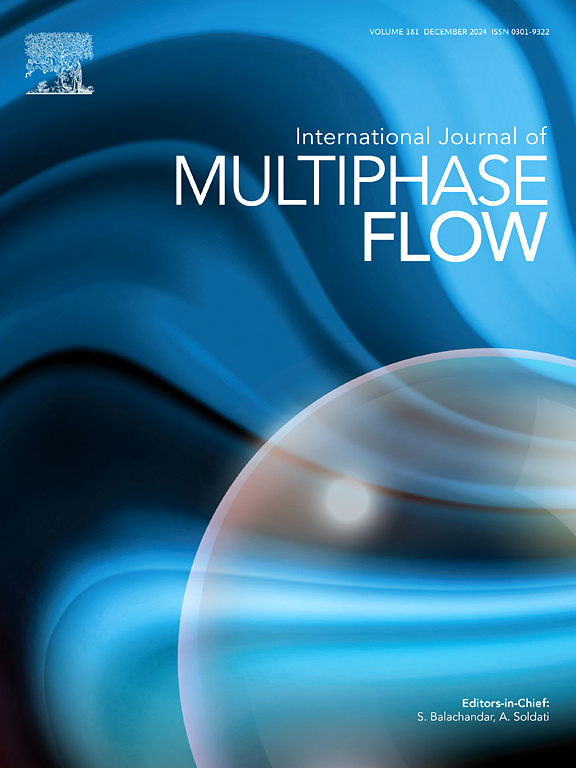Transient bubble rising in the presence of a surfactant at very low concentrations
IF 3.6
2区 工程技术
Q1 MECHANICS
International Journal of Multiphase Flow
Pub Date : 2025-03-08
DOI:10.1016/j.ijmultiphaseflow.2025.105205
引用次数: 0
Abstract
We study the formation of the dynamic adsorption layer when a bubble is released in a tank containing water with a tiny amount of surfactant. The influence of the sorption kinetic constants is examined by comparing the experiments with Sodium Dodecyl Sulfate (SDS) and Triton X-100. The experiments allowed us to determine the parameter conditions that lead to a stable bubble rising and to validate the simulation. A simple scaling analysis and the simulation show that the formation of the dynamic adsorption layer can be split into three phases characterized by disparate time scales. The mechanisms controlling those phases are surfactant convection, adsorption–desorption, and diffusion. The amount of surfactant adsorbed onto the interface increases monotonously throughout the three phases. The experiments and the simulation show that the rising velocity reaches a maximum at times of the order of ( is the desorption constant) when the dynamic adsorption layer is practically formed. This occurs even when only traces of surfactant are present in the liquid. The non-monotonous behavior of the maximum surfactant surface concentration is explained in terms of the reverse flow in the rear of the bubble right after the bubble release. This work contributes to the understanding of the complex interplay between hydrodynamics and surfactant transport and kinetics over bubble rising.

在极低浓度的表面活性剂存在下产生的瞬时气泡
我们研究了当气泡在含有少量表面活性剂的水箱中释放时动态吸附层的形成。通过与十二烷基硫酸钠(SDS)和Triton X-100的吸附实验对比,考察了吸附动力学常数的影响。实验使我们能够确定导致气泡稳定上升的参数条件,并验证模拟结果。简单的尺度分析和模拟表明,动态吸附层的形成可以分为三个阶段,其特征是不同的时间尺度。控制这些相的机制是表面活性剂对流、吸附-解吸和扩散。表面活性剂吸附在界面上的量在整个三相中单调增加。实验和模拟结果表明,当实际形成动态吸附层时,上升速度在kd−1数量级(kd为解吸常数)达到最大值。即使液体中只有微量的表面活性剂,这种情况也会发生。表面活性剂最大表面浓度的非单调性可以用气泡释放后气泡后部的反向流动来解释。这项工作有助于理解流体力学和表面活性剂输运以及气泡上升动力学之间的复杂相互作用。
本文章由计算机程序翻译,如有差异,请以英文原文为准。
求助全文
约1分钟内获得全文
求助全文
来源期刊
CiteScore
7.30
自引率
10.50%
发文量
244
审稿时长
4 months
期刊介绍:
The International Journal of Multiphase Flow publishes analytical, numerical and experimental articles of lasting interest. The scope of the journal includes all aspects of mass, momentum and energy exchange phenomena among different phases such as occur in disperse flows, gas–liquid and liquid–liquid flows, flows in porous media, boiling, granular flows and others.
The journal publishes full papers, brief communications and conference announcements.

 求助内容:
求助内容: 应助结果提醒方式:
应助结果提醒方式:


